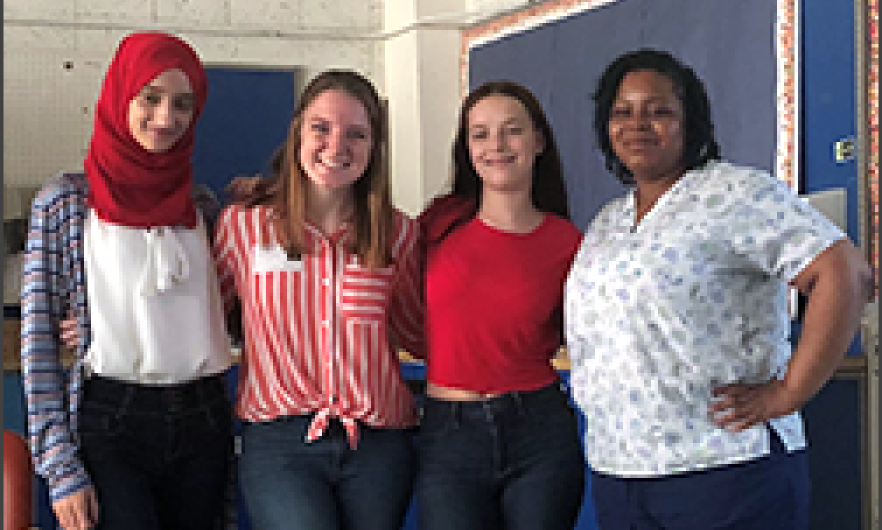A Community-Driven Research Approach to Environmental Health in Baltimore City Public Schools

Every year the Johns Hopkins Urban Health Institute provides funding to community-university—graduate, faculty, and undergraduate—partnerships that most successfully demonstrate the potential for advancing the health and well-being of the residents of Baltimore.
In 2017, Arshdeep Kaur and Madison Dutson, at the time undergrad students at Johns Hopkins, and Shane Gordon became recipients of UHI’s Small Grant Award following their participation in our Community-Driven Research Day for their partnership and work with Cool Green Schools in Baltimore City. Below is a blog Arshdeep and Madison wrote about the on-going collaboration. Read the project abstract here.
By Arshdeep Kaur and Madison Dutson, Johns Hopkins University

In Baltimore City Public Schools (BCPS) environmental health challenges are the norm. Last January, BCPS made headlines when photos of students wearing heavy jackets indoors went viral—in the midst of harsh winter temperatures, their schools had inadequate heating. During the first week of school this Fall, dozens of schools were again closed early, this time due to lack of air conditioning. These extreme temperature conditions are just one of the environmental challenges that Baltimore students and teachers face. Poor air quality, a host of asthma triggers, and inadequate maintenance threaten students’ health and interfere with their learning. Tackling this problem requires an innovative, community-driven, and sustainable approach.
Our research aims to address this need through community partnerships and a focus on youth empowerment in order to bring about lasting change. Rooted in the belief that students are the experts in their own lives, this program empowers young people to study, understand, and change the world around them. This is the central value of a community-driven approach—allowing researchers to support those who are affected by public health issues to find solutions that are relevant and effective.
The idea for our project began in March 2017 when Madison Dutson and Arshdeep Kaur, two Johns Hopkins University undergraduate students, and Dr. Megan Latshaw of the Bloomberg School of Public Health, partnered with Cool Green Schools. The community research partnership with this local non-profit, led by Shan Gordon, was funded by the Johns Hopkins Urban Health Institute.

After planning and collaborating with teachers at two schools, the project began in spring 2018. Students at Patterson High School and Baltimore Polytechnic Institute received an introduction to the principles of environmental health, and took part in a building audit led by mechanical engineer Keith Madigan. Using their understanding of environmental health and the conditions at their school, students identified the environmental health issues that mattered most to them. With guidance from Johns Hopkins students, they designed and carried out research projects and interventions to address their chosen issues. Students quickly took to the task, creating projects ranging from a flower cart to improve classmates’ mental health to placing mini-basketball hoops over trash cans to encourage their classmates to “make a trashket” instead of littering. Other groups studied temperature and air quality differences throughout their school building or tested water quality in the bathrooms. All of their projects displayed students’ creativity, enthusiasm, and commitment to making their school a better place.
After participating in the program, survey results showed that the number of students who believed that they could change their school doubled. Similarly, the number of students who indicated they had many people who would support their efforts to improve conditions also increased and nearly doubled. While students are by no means expected to remedy all of the problems in their schools or communities, it is important for young people to understand that they do have the power to study and change their environments. This data speaks to the long-term positive impacts of prioritizing the ideas and needs of youth and supporting them in their learning and growth that would not have been possible with another research approach.
The program’s effects were not limited to students—Robert Marinelli, an environmental science teacher whose classes participated, was extremely impressed by the level of work his students completed. After the project, Mr. Marinelli began creating new lesson plans to implement the following year to further challenge students and involve them in hands-on environmental science work. These types of structural changes ensure that the program has a positive effect on not just the students who participated but on future pupils as well.

As the research team moves forward with the program for the 2018-2019 school year, we are focused on expanding student enrollment and continuing to support students in their scientific exploration. The student and teacher responses to this program are important evidence of the need for community-driven approaches to improve health. Empowering youth and affected communities to understand and improve their own wellbeing and environment enables them to create sustainable solutions for years to come.
References:
[i] http://www.baltimoresun.com/news/maryland/education/k-12/bs-md-ci-gofundme-schools-20180104-story.html
[ii] http://www.baltimoresun.com/news/maryland/education/k-12/bs-md-ac-schedule-20180906-story.html
